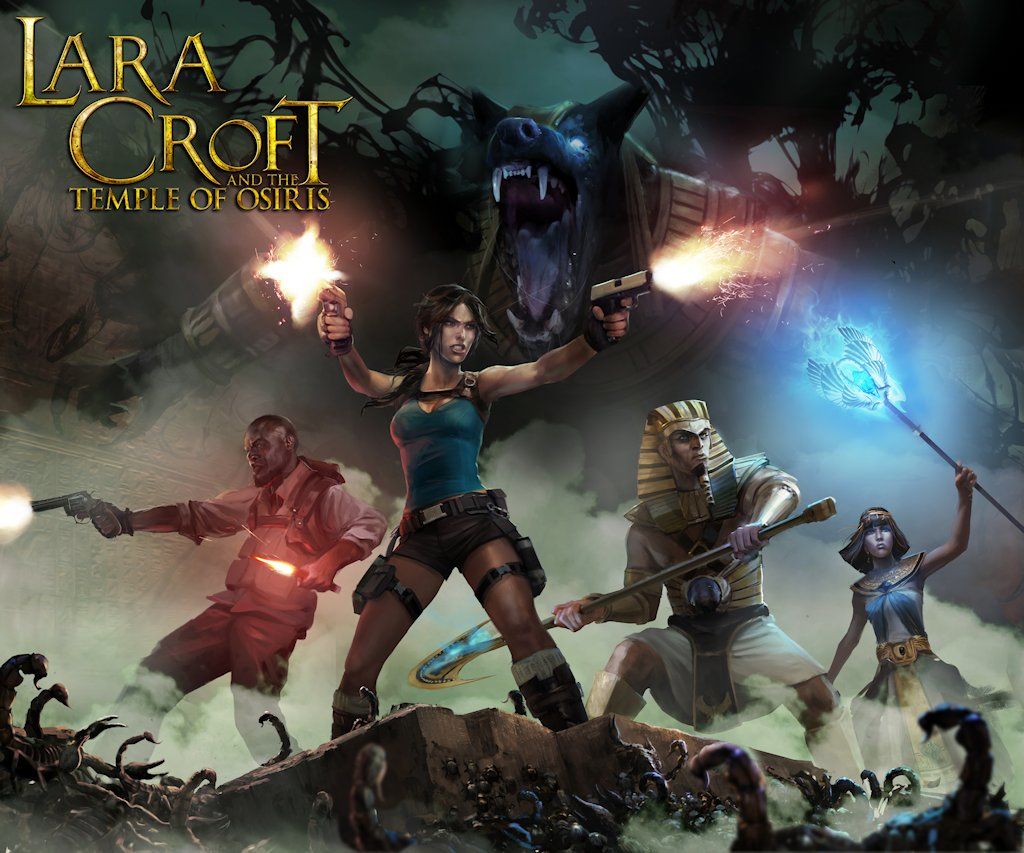- Format: Xbox One (version reviewed), PS4, PC
- Unleashed: Out Now
- Publisher: Square Enix
- Developer: Crystal Dynamics
- Players: 1-4 (online/offline)
- Site: http://www.laracroft.com/
- Game code provided by Xbox
You’ll notice that while this is happy to declare itself a Lara Croft game, nowhere do the franchisetastic words ‘Tomb Raider’ appear. That’s because it’s a sort-of sequel to Guardian of Light, itself a spinoff from the main series. The ironic thing is that the incidences of raiding tombs here are almost certainly more numerous than in any other game featuring Ms Croft. It’s pretty much all you do.
Semantic frustrations aside, following on from GoL means that Lara Croft and the Temple of Osiris (or as we prefer to call it because it sounds like somebody sneezing mid-sentence, Lara Croft ATTOO) is a dungeon-crawling co-op shooter. This time however, the player count has been doubled to four (count ’em!) people max per game, locally or online. Online matches take a little while to find, but they are there. Of more concern is the fact that disconnections are not uncommon and, while it can be fun aiming for a higher score than your compadres or simply messing about between dungeons, the camera doesn’t know what to do if you have people refusing to work as a team.
The game is played with a fixed camera, but you always have a good view of the action when playing alone. This however is because the perspective – and genre – has its roots in PC gaming, where people will tend to be hunched over mere inches from the screen. Therefore, don’t expect to see an awful lot of detail unless you have a gigantic TV or, of course, are playing the PC version. Speaking of graphics things look nice enough, but the decision to refuse to make last-gen console versions is rather odd. There’s nothing here that would test the PS3 or 360.

This game is so funny it will crack you up! Ha ha ! Um, not really. It’s not funny at all.
The story is harmless enough, but the potential to be found in the rich depths of Egyptian mythology is quite frankly wasted here. The script is cheesier than a Wotsit poking out of a Dairylea slice with acting to match, and it only really affects gameplay in terms of spikes to avoid and skeletons, bugs, and crocodile men to kill. There are a handful of bosses, which take their cue from the myths a bit better, but in gameplay terms ultimately fall into the ‘expose and hit the weak spot’ trap.
To reverse on our metaphorical review bicycle a little, let’s talk about gameplay in a bit more detail. Move with the left stick, aim with the right, and shoot with a button. You can have a maximum of four weapons assigned to hotkeys, and all but your piddly pistols (which the game annoyingly defaults to each time you respawn) rely on finite ammo. You also get a remotely detonated bomb with regenerating stock, a handy dodge button, a jump button which allows you to bounce around, a grapple which you can use at strictly determined points, and an ‘interact’ button for pulling switches and rolling around huge balls.
Enemies and pots will often contain ammo or health, though in truth you won’t need to worry about those meters too much. Very few weapons drain ammo at an alarming rate, and the cookie cutter AI ensures that avoiding damage is usually a simple case of keeping your distance and dodging at the appropriate time. There are puzzles scattered through the game, but most of them are overly simple. The overall low difficulty level, when combined with the small number of fairly short dungeons, means that you can run through the story with less than a dozen deaths in just 4-5 hours. That, however, is not how the game was designed to be played.

As you can clearly see, this screenshot shows… er……
Well yes, obviously the developers want you to jog through the story they’ve made, but this isn’t an adventure meant to be played through once then abandoned. It’s all about the gems. Shiny gems are everywhere; left lying around, hidden in pots, given as rewards for completing challenges and defeating bosses, under bombable floors, in out-of-the-way corners, and more. Dotted around the overworld – and found in large numbers at the end of a dungeon – are chests containing random loot. Each chest demands a certain cost for opening, and inside you might find an accessory (to boost health, damage, resistance to certain attacks etc) or a new weapon. As some chests are very expensive and the rewards within randomly assigned, the idea (as with Destiny) is to keep going back through the game – ideally with friends – in the quest for new and better stuff. The problem is that there’s not an awful lot of game to keep replaying, and (like Destiny) what’s there isn’t really interesting or fun enough to sustain interest for very long.
It’s not a bad game by any means, but nor is it one people will be begging to play over and over and over again. The puzzle-centred Challenge Tombs had the potential to change this, as they’re easily the most interesting and best designed part of the package; but they’re fixed, very short, and just five in number. Even if you have more luck than us in finding online games, once the story is done, we can’t imagine most people playing this as anything other than something to pass the time between other things they’d rather be doing.









Comments